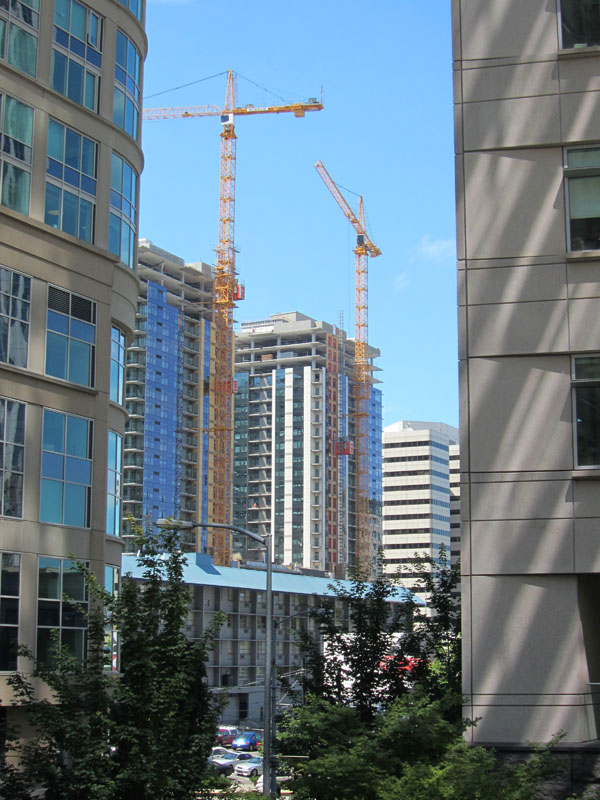Density Shrugged

In progressive cities like Seattle, pointing out that it would be a good idea to make our urban areas more compact, walkable, and better served by transit is about as controversial as saying that we should turn out the lights when we leave the room. And it’s no secret that density is the essential enabling ingredient, the secret sauce for resource-efficient, economically competitive cities.
So why then, do we still seem to be so attached to the notion of taxing increased density? Because that is exactly what we are doing when we require developers to pay for public benefits such as affordable housing or farmland preservation if they want to build above a given height or capacity limit. Known as incentive zoning, it’s the standard formula in pretty much every U.S. city that’s experiencing growth. The trouble is, when we place a toll on the production of density, we are making the fundamental mistake of taxing the very thing we want.
Most everyone is on board with giving tax breaks to pursuits deemed vital—renewable energy, for example—in order to accelerate adoption. In the case of high density development, however, our inclination tends to be just the opposite, even though we know that densifying cities is just as critical as developing renewable energy if we hope to achieve meaningful, long-term reductions in energy use and climate-changing emissions. Can you imagine the ruckus that would ensue if a politician proposed giving tax breaks to developers if they build taller?
It’s a given among most urban planning policy wonks that if a municipality enacts a zoning change that enables higher density and therefore higher value development, then the public has a RIGHT to appropriate some of that value. Yet most of these same wonks also understand the critical role of urban density and are in favor of upzones to allow more of it. Do you notice the contradiction, reader? Attaching an extra fee to density encumbers its production, an outcome completely at odds with the well-justified reasons for upzoning in the first place. The end result is we get less of what we want, and what we do get is more expensive.
The time has come for us to get past the lingering anti-urban biases that prevent us from fully acting on the reality that the big city is not the enemy of the planet, but actually its best friend; the reality that density is a pivotal solution to a looming, time-critical planetary catastrophe that necessitates doing everything we can to create more of it quickly and efficiently.
And one significant step we can take is to stop expecting the skinny guys to go on a diet. The people who live in dense urban cores instead of sprawling suburbs are already contributing to the public good, because simply by living where they live, their environmental footprint is greatly reduced. We shouldn’t be applying density tolls that effectively tax that lifestyle choice and make it more expensive.
If we’re looking for a particular group that ought to bear a greater share of the tax burden for broadly shared public benefits like affordable housing, the rational choice would be those who live in low density—that is, put the fat guys on the diet. Because single-family homes in a city like Seattle take up so much prime land, they play a major role in jacking up housing prices across the board. Low-density land use also contributes to increased development pressure on the ex-urban fringe, simply because it uses up more land closer in. Rural preservation programs such as Transferable Development Rights ought to be imposing their fees on low-density property owners, not on dense development that inherently ameliorates the root cause of rural land consumption.
None of this is to say we don’t have an obligation to publicly fund important public benefits like affordable housing and open space. We just need to be careful that the funding choices we make do not compromise our broader sustainability goals. No, finding new sources of funds definitely will not be easy. Ultimately, mobilizing the necessary support for such restructuring is going to take a big shift in the cultural mindset that still sees city building as some sort of necessary evil, and by extension, development as an easy target for extraction.
The new mindset we need would celebrate the crazy-rapid pace of apartment development that’s now happening in Seattle’s Capitol Hill and Ballard neighborhoods as an accomplishment with as much (or more?) long-term sustainability significance as say, a new large-scale wind turbine farm. The mindset we need would recognize the unmatched sustainable development opportunity in South Lake Union—the envy of cities nationwide—and would strive to remove delays and encumbrances rather than create them (territorial views of the Space Needle, for example, would land at the bottom of the priority list).
And yes, the mindset we need would, in fact, support tax incentives for higher density development.
>>>
Dan Bertolet once wrote a blog called hugeasscity.
Photo of the 650-unit Via6 apartments—one of the highest density housing developments ever built in Seattle—by the author.

